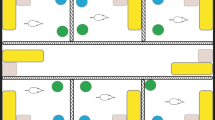Abstract
The behavior of three common shrew species was compared in a test of pairwise placement in a neutral territory (10 min) for various population densities in natural habitats and for animals kept isolated or in groups in open-air cages. The behavior of the animals captured in nature was regarded as the norm. We analyzed the total number of social contacts (as an index of social activity), as well as the frequencies of direct and ritualized aggressive interactions, rejection of contacts, and friendly interactions (as parameters characterizing the structure of interactions). Isolation of the shrews proved to decrease their social activity. The highest frequency of interactions was observed in the animals kept in groups in open-air cages. The level of “sociality” and changes in behavior related to differences in population density in the three shrew species can be more significant than the species-specific differences in their behavior.
Similar content being viewed by others
REFERENCES
Bulatova, N., Searle, J.B., Bystrakova, N., Nadjafova, R., Shchipanov, N., and Orlov, V., The Diversity of Chromosome Races in Sorex araneus from European Russia, Acta Theriol., 2000, suppl. 1, pp. 33–46.
Churchfield, S., The Natural History of Shrews, London: Christopher Helm, 1990.
Crowcroft, P., Notes on the Behaviour of Shrews, Behaviour, 1955, vol. 8, pp. 63–80.
Crowcroft, P., The Life of the Shrew, London: Reinhardt, 1957.
Crowcroft, P. and Rowe, F.P., The Growth of Confined Colonies of the Wild House Mouse (Mus musculus L.): The Effect of Dispersal on Female Fecundity, Proc. Zool. Soc. London, 1957, vol. 131, no.3, pp. 359–370.
Eisenberg, J.F., Studies on the Behaviour of Sorex vagrans, Am. Midl. Nat., 1964, vol. 72, no.2, pp. 417–425.
Gol'tsman, M.E., Popov, S.V., Chabovskii, A.V., and Borisova, N.G., The Sociality Syndrome: A Comparative Study of the Behavior of Gerbils, Zh. Obshch. Biol., 1994, vol. 55, no.1, pp. 49–68.
Hanski, I., Peltonen, A., and Kaski, L., Natal Dispersal and Social Dominance in the Common Shrew Sorex araneus, Oikos, 1991, vol. 62, no.1, pp. 48–58.
Moraleva, N.V., Intraspecific Interactions in the Common Shrew Sorex araneus in Central Siberia, Ann. Zool. Fenn., 1989, vol. 26, pp. 425–432.
Oleinichenko, V.Yu., Behavior of Shrews Sorex volnuchini and S. raddei, Zool. Zh., 2000, vol. 79, no.8, pp. 939–953.
Pogudkina, L.N. and Luk'yanova, I.V., Study of the Social Behavior of Shrews (Soricidae) under Laboratory Conditions, in Povedenie i kommunikatsiya mlekopitayushchikh (Behavior and Communication in Mammals), Moscow: Inst. Evol. Morfol. Ekol. Zhivotn., Ross. Akad. Nauk, 1992, pp. 5–19.
Popov, S.V. and Chabovskii, A.V., Population Density, Social Environment, and Behavior: Possible Relationships, in: Ekologiya populyatsii: struktura i dinamika. Mater. Vseros. soveshch. (Population Ecology: Structure and Dynamics. Proc. All-Russia Conf.), Moscow: Ross. S–kh. Akad., 1995, vol. 1, pp. 183–202.
Rychlik, L., Evolution of Social Systems in Shrews, in Evolution of Shrews, Bialowieza: Mammal. Res. Inst., 1998, pp. 347–406.
Sergeev, V.E., Comparative Evaluation of Group Interactions in Insectivores, Povedenie zhivotnykh v soobshchestvakh. Mater. III Vsesoyuz. konf. po povedeniyu zhivotnykh (Animal Behavior in Communities. Proc. 3rd All-Union Conf. on Animal Behavior), Moscow: Nauka, 1983, vol. 2, pp. 291–292.
Shchipanov, N.A., Some Aspects of Resistance of Small Mammals, Usp. Sovrem. Biol., 2000, no. 1, pp. 73–87.
Shchipanov, N.A. and Oleinichenko, V.Yu., Belobryukhaya belozubka: Povedenie, prostranstvenno-etologicheskaya i funktsional'naya struktura populyatsii (White-Toothed Shrew: Behavior and the Spatial–Ethological and Functional Structure of Population), Moscow: Nauka, 1993.
Shchipanov, N.A., Kalinin, A.A., Oleinichenko, V.Yu., and Demidova, T.B., General Behavioral Characteristics of Shrews Sorex araneus, S. caecutiens, S. minutus, and S. isodon (Insectivora, Soricidae), Zool. Zh., 1998, vol. 77, no.4, pp. 444–458.
Shchipanov, N.A., Kalinin, A.A., Oleinichenko, V.Yu., Demidova, T.B., Goncharova, O.B., and Nagornev, F.V., On the Method for Studying Space Utilization by the Longtailed Shrews, Zool. Zh., 2000, vol. 79, no.3, pp. 362–371.
Shchipanov, N.A., Kalinin, A.A., Oleinichenko, V.Yu., Demidova, T.B., and Goncharova, O.B., Space Utilization by the Masked Shrew Sorex caecutiens. Characteristics of Home Ranges and Distant Migrations, Zool. Zh., 2001, vol. 80, no.5, pp. 576–585.
Author information
Authors and Affiliations
Rights and permissions
About this article
Cite this article
Kalinin, A.A., Shchipanov, N.A. Density-Dependent Behavior of Shrews (Sorex araneus, S. caecutiens, and S. minutus) under Natural and Experimental Conditions. Biology Bulletin 30, 576–583 (2003). https://doi.org/10.1023/B:BIBU.0000007714.30461.3e
Issue Date:
DOI: https://doi.org/10.1023/B:BIBU.0000007714.30461.3e




